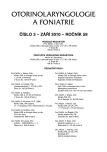Pepsin and Weakly Acidic Esophageal Reflux
Authors:
Karol Zeleník; P. Schwarz; M. Lázničková; Pavel Komínek
Authors‘ workplace:
Klinika ORL FN Ostrava
přednosta doc. MUDr. P. Komínek, Ph. D., MBA
Published in:
Otorinolaryngol Foniatr, 59, 2010, No. 3, pp. 124-128.
Category:
Original Article
Overview
Pepsin in weakly acid and slightly alkaline refluxes is considered to be main factor responsible for damage of hypopharyngeal and laryngeal epithelial cells. Its ability to stay stable and active also in weakly acid and slightly alkaline pH and its negative impact on epithelial cells are reasons, why some patients do not response even for aggressive antireflux therapy. Proper diagnosis of weakly acid and slightly alkaline refluxes is possible only with combination of pH-metry and multi-channel intraluminal impedance. Nowadays, pepsin inhibitors and pepsin receptor antagonists are developed to decrease negative impact of pepsin on laryngeal and hypopharyngeal epithelial cells in future.
Key words:
extraesophageal reflux, weakly acid reflux, pepsin, esophageal impedance.
Sources
1. Altman, K. W., Radosevich, J. A.: Enexpected consequences of proton pump inhibitor use. Otolaryngol Head Neck Surg., 141, 2009, s. 564-566.
2. Anandasabapathy, S., Jaffin, B. W.: Multichannel intraluminal impedance in the evaluation of patients with persisistent globus on proton pump inhibitor terapy. The Annals of Otology, Rhinology & Laryngology, 115, 2006, 8, s. 563-570.
3. Conchillo, J. M., Smout, A. J.: Review article: intra-oesophageal impedance monitoring for the assessment of bolus transit and gastro-oesophageal reflux. Aliment Pharmacol Ther, 29, 2008, s. 3-14.
4. Dolina, J., Kala, Z., Kroupa, R., Prokešová, J., Hep, A.: Impedance a pH-metrie jícnu – staronová vyšetřovací metoda? Folia Gastroenterol. Hepatol., 62, 2008, s. 6-9.
5. Dolina, J., Kala, Z., Prokešová, J., Kroupa, R., Procházka, V., Hep, A.: Nové možnosti v diagnostice refluxní nemoci jícnu. Čes a Slov Gastroent. a Hepatol., 63, 2009, s. 186-190.
6. Johnston, N., Dettmar, P. W., Bishwokarma, B. et al.: Activity/stability of human pepsin: implications for reflux attributed laryngeal disease. Laryngoscope, 117, 2007, s. 1036-1039.
7. Johnston, N., Dettmar, P. W., Lively, M. O. et al.: Effect of pepsin on laryngeal stress protein (Sep70, Sep53, and Hsp70) response: role in laryngopharyngeal reflux disease. The Annals of Otology, Rhinology & Laryngology, 115, 2006, 1, s. 47-58.
8. Johnson, N., Knight, J., Dettmar, P. W. et al.: Pepsin and carbonic anhydrase isoenzyme III as diagnostic markers for laryngopharyngeal reflux disease. Laryngoscope, 114, 2004, s. 2129-2134.
9. Johnston, N., Wells, C. W., Samuels, T., L., Blumin, J. H.: Pepsin in nonacidic refluxate can damage hypopharyngeal epithelial cells. The Annals of Otology, Rhinology & Laryngology, 118, 2009, 9, s. 677-685.
10. Reichel, O., Issing, W. J.: Impact of different threshold for 24-hour dual probe pH monitoring in patients with suspected laryngopharyngeal reflux. The Journal of Laryngology & Otology, 122, 2008, s. 485-489.
11. Samuels, T. L., Johnston, N.: Pepsin as a causal agent of inflamation during nonacidic reflux. Otolaryngol Head Neck Surg., 141, 2009, s. 559-563.
12. Silny, J.: Intraluminal multiple electric impedance procedure for measurement of gastrointestinal motility. J. Gastrointest. Motil, 1991, 3, s. 151-162.
13. Smit, C. F., Tan, J., Davriese, P. P., Mathus-Vliegen, L. M. H., Brandsen, M., Schouwenburg, P. F.: Ambulatory pH measurements at the upper esophageal sphincter. Laryngoscope, 108, 1998, s. 299-302.
14. Vincent, D. A., Garrett, J. D., Radionof, S. L. et al.: The proximal probe in esophageal pH monitoring: development of a normaive database. J. Voice, 14, 2000, s. 247-254.
15. Zeleník, K., Komínek, P., Stárek, I., Machytka, E.: Extraezofageální reflux (1. část). Epidemiologie, patofyziologie a diagnostika. Otorinolaryng. a Foniat. /Prague/, 57, 2008, s. 143-150.
Labels
Audiology Paediatric ENT ENT (Otorhinolaryngology)Article was published in
Otorhinolaryngology and Phoniatrics

2010 Issue 3
Most read in this issue
- Harmless Decongescents and Provident Application of Decongescents
- Pepsin and Weakly Acidic Esophageal Reflux
- Vestibular Evoked Myogenic Potentials (VEMP) in Diagnostics of Vestibulopathies
- Czech Version of the Quality of Life Questionnaire for Patients with Chronic Rhinosinusitis SNOT-22 (Sino-nasal Outcome Test)
